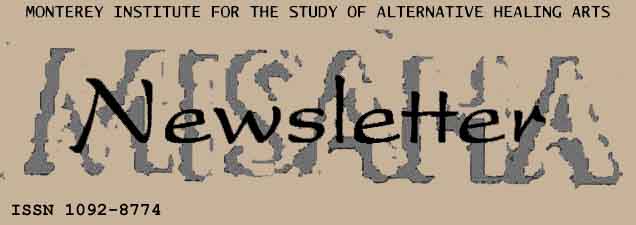
Issue #28 - #29 |

Issue #28 - #29 |
2000 COMMENTS* ON THE NCCAM FIVE-YEAR PLAN**
Dr. Stephen E. Straus, Director
NCCAM NIH
Dear Dr. Straus:
I believe that the NCCAM five-year plan under development is a document of great importance. The way you are approaching this task, by encouraging contributions by many interested parties, is highly commendable. I thank you for inviting me to comment on this plan. The following suggestions are based on a ten-year-long inquiry into methodology of studying the phenomenon of biofield healing called otherwise psi, energy, polarity healing, qigong, reiki, therapeutic touch, yoga, etc.
1. Taxonomy of CAM would gain heuristic strength if developed with respect to a clearly formulated criterion. One of the criteria that could be used is the methodology of clinical evaluation. The latter depends on what is perceived to be the essential curative agent of CAM intervention. This criterion divides the whole field of CAM into two basic domains: the domain of untested chemical and physical remedies or standardizable procedures and the domain of biofield communication that includes “mind-body medicine” as well as “healing” by intent of psi-gifted individuals, using various techniques, or by high expectation of physicians. The old Oriental and other unconventional medical systems are usually open to both of these domains while conventional Western medicine is open only to the first domain as yet. An early version of my taxonomy of CAM is presented in MISAHA Newsletter # 11, 1995 and my article in Townsend Letter for Doctors and Patients # 175, 1998, pp. 92-95.
2. Biophysical and clinical study of the biofield that is manifested in the CAM of the second domain may result in a fundamental contribution to biology and medical science since it will shed light on the general control system of the organism, provide adequate concept of pathology and lead to the understanding of mechanisms of the ancient medical systems such as acupuncture and qigong (see my article “Alternative Biophysics: to Invest in the Study of the Biofield” in MISAHA Newsletter #23-28, 1999, pp. 2-9, enclosed).
3. Methodology of clinical studies aimed at determining the efficacy of various techniques and therapies of the second domain must recognize the “principle of uncertainty” discussed in the above-mentioned article “Alternative Biophysics.” The impact of the practitioner (his/her natural ability, psychological environment, etc.) may be much greater than the technique used, therefore results cannot be extrapolated on other practitioners of the same technique. Placebo effect or the intentional engagement of the expectation (and through the mind, the biofield) of the patient may be an essential part of the intervention, therefore sham control does not make sense. Clinical results should be compared to the statistical outcome data of conventional treatments.
MISAHA would be glad to participate in the further elaboration of the
NCCAM Plan if you believe that the above suggestions make sense.
Respectfully,
Savely Savva
Mail donation and/or subscription to:
   |